Abstract
Allograft rejection results from the specific recognition by host CD8+ T cells of allogeneic major histocompatibility complex (MHC) molecules on the tissue graft. The specificity of this cellular response is determined by the molecular interaction of the T-cell receptor (TCR) on host T cells with the MHC molecule and its bound ligand on the grafted tissue. To better understand the precise manner by which the TCR interacts with the MHC-peptide complex and how to therapeutically intervene, we have studied the allogeneic response to the mouse class I MHC molecule Ld. In this report, the therapeutic potential of a synthetic peptide derived from the TCR V beta 8 variable region that predominates in responses to Ld was tested. This V beta 8-derived peptide was found to dramatically and specifically block the in vivo and in vitro allogeneic response to Ld. Furthermore, this specific blocking is not dependent upon the presence of V beta 8+ effector cells nor does the V beta 8 peptide bind to the Ld ligand binding cleft. We propose that this peptide functions as an antagonist, competing with the native TCR for recognition of the Ld molecule.
Full text
PDF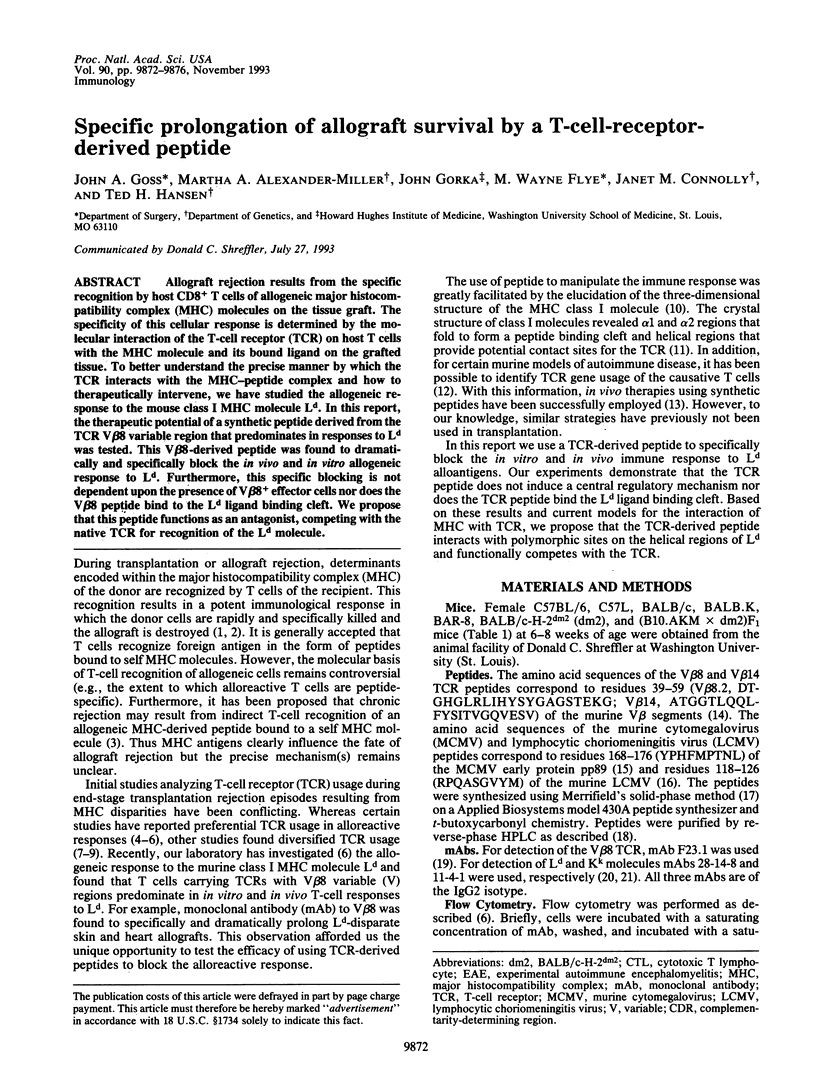
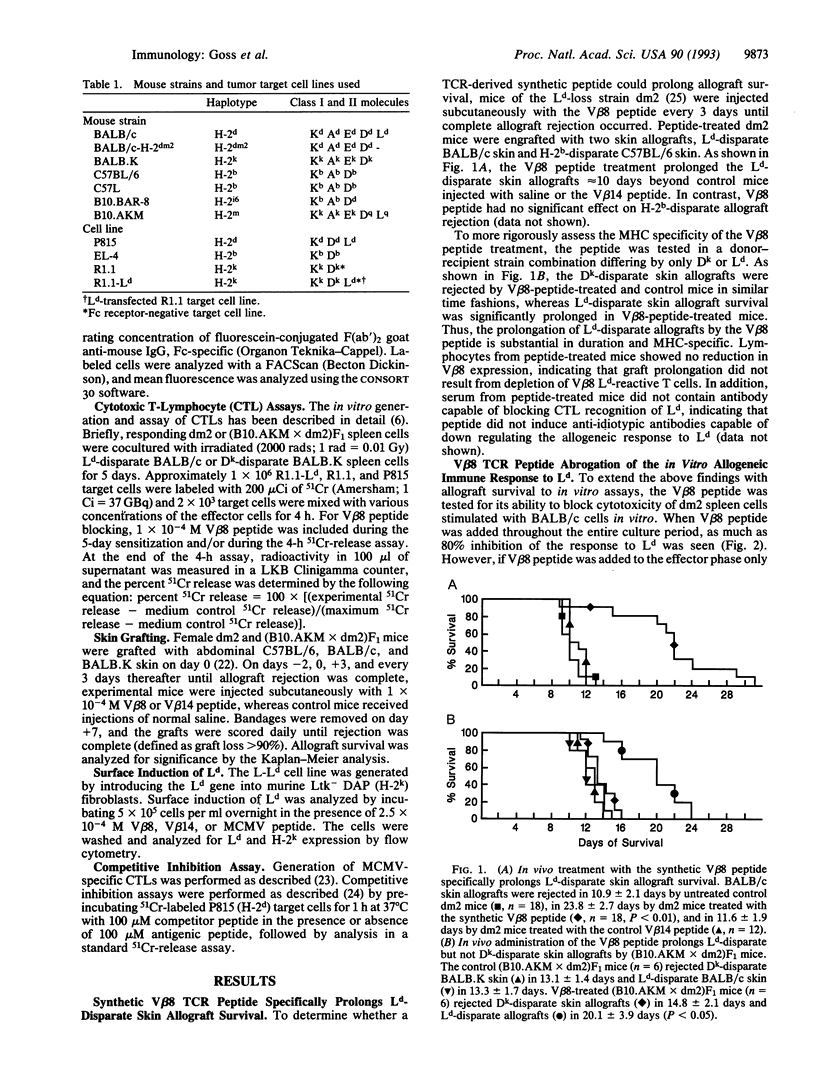
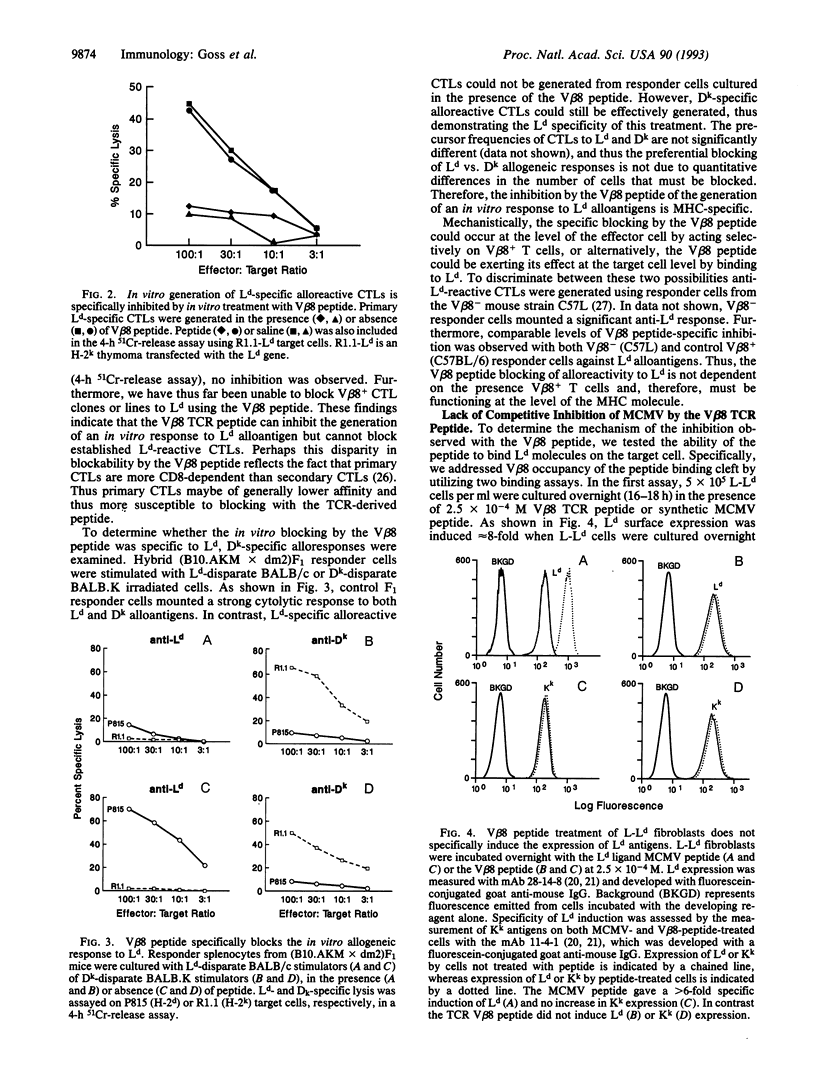
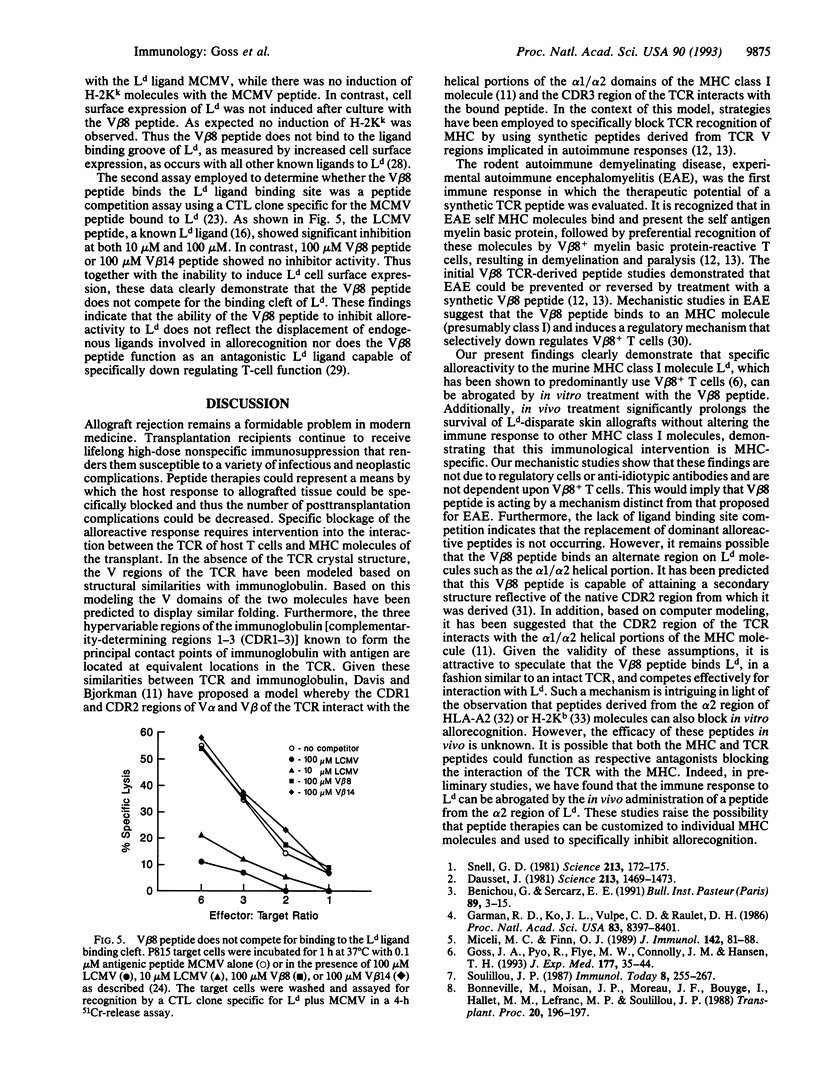
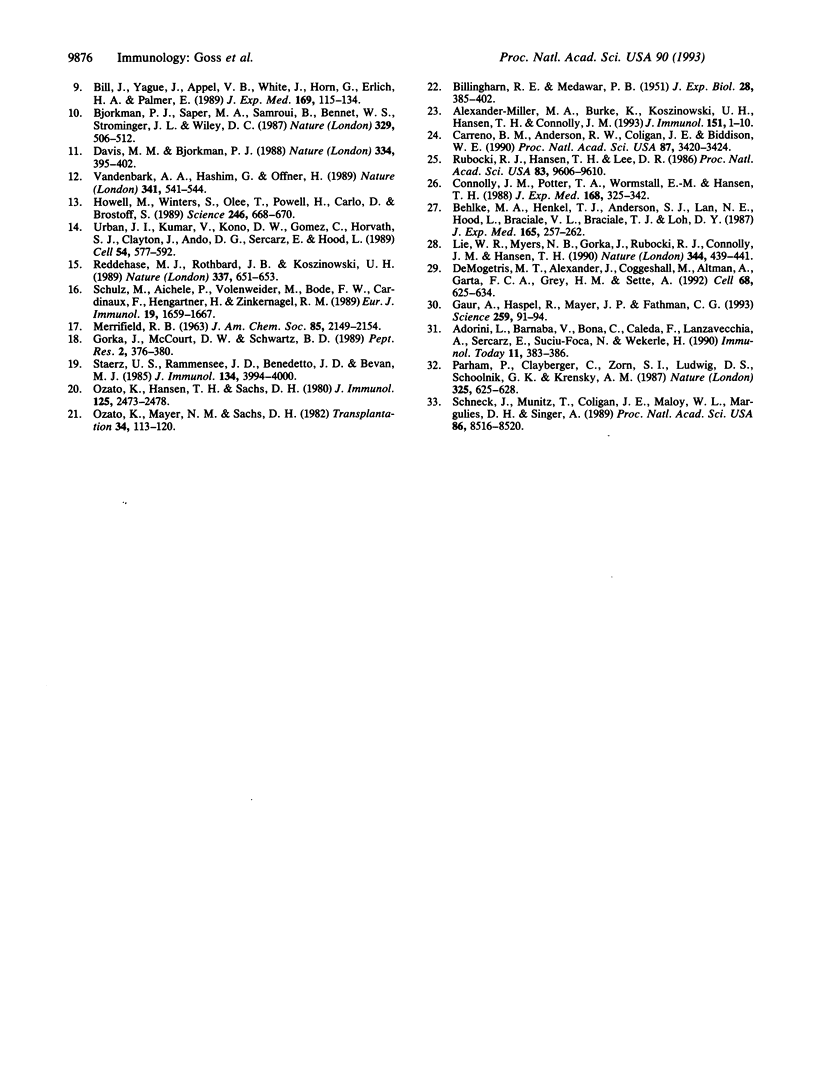
Selected References
These references are in PubMed. This may not be the complete list of references from this article.
- Adorini L., Barnaba V., Bona C., Celada F., Lanzavecchia A., Sercarz E., Suciu-Foca N., Wekerle H. New perspectives on immunointervention in autoimmune diseases. Immunol Today. 1990 Nov;11(11):383–386. doi: 10.1016/0167-5699(90)90148-3. [DOI] [PubMed] [Google Scholar]
- Alexander-Miller M. A., Burke K., Koszinowski U. H., Hansen T. H., Connolly J. M. Alloreactive cytotoxic T lymphocytes generated in the presence of viral-derived peptides show exquisite peptide and MHC specificity. J Immunol. 1993 Jul 1;151(1):1–10. [PubMed] [Google Scholar]
- Behlke M. A., Henkel T. J., Anderson S. J., Lan N. C., Hood L., Braciale V. L., Braciale T. J., Loh D. Y. Expression of a murine polyclonal T cell receptor marker correlates with the use of specific members of the V beta 8 gene segment subfamily. J Exp Med. 1987 Jan 1;165(1):257–262. doi: 10.1084/jem.165.1.257. [DOI] [PMC free article] [PubMed] [Google Scholar]
- Bill J., Yagüe J., Appel V. B., White J., Horn G., Erlich H. A., Palmer E. Molecular genetic analysis of 178 I-Abm12-reactive T cells. J Exp Med. 1989 Jan 1;169(1):115–133. doi: 10.1084/jem.169.1.115. [DOI] [PMC free article] [PubMed] [Google Scholar]
- Bjorkman P. J., Saper M. A., Samraoui B., Bennett W. S., Strominger J. L., Wiley D. C. Structure of the human class I histocompatibility antigen, HLA-A2. Nature. 1987 Oct 8;329(6139):506–512. doi: 10.1038/329506a0. [DOI] [PubMed] [Google Scholar]
- Bonneville M., Moisan J. P., Moreau J. F., Bouyge I., Hallet M. M., Lefranc M. P., Soulillou J. P. TRG alpha, beta, and gamma gene rearrangements in human alloreactive T cell clones extracted from a rejected kidney. Transplant Proc. 1988 Apr;20(2):196–198. [PubMed] [Google Scholar]
- Carreno B. M., Anderson R. W., Coligan J. E., Biddison W. E. HLA-B37 and HLA-A2.1 molecules bind largely nonoverlapping sets of peptides. Proc Natl Acad Sci U S A. 1990 May;87(9):3420–3424. doi: 10.1073/pnas.87.9.3420. [DOI] [PMC free article] [PubMed] [Google Scholar]
- Connolly J. M., Potter T. A., Wormstall E. M., Hansen T. H. The Lyt-2 molecule recognizes residues in the class I alpha 3 domain in allogeneic cytotoxic T cell responses. J Exp Med. 1988 Jul 1;168(1):325–341. doi: 10.1084/jem.168.1.325. [DOI] [PMC free article] [PubMed] [Google Scholar]
- Dausset J. The major histocompatibility complex in man. Science. 1981 Sep 25;213(4515):1469–1474. doi: 10.1126/science.6792704. [DOI] [PubMed] [Google Scholar]
- Davis M. M., Bjorkman P. J. T-cell antigen receptor genes and T-cell recognition. Nature. 1988 Aug 4;334(6181):395–402. doi: 10.1038/334395a0. [DOI] [PubMed] [Google Scholar]
- De Magistris M. T., Alexander J., Coggeshall M., Altman A., Gaeta F. C., Grey H. M., Sette A. Antigen analog-major histocompatibility complexes act as antagonists of the T cell receptor. Cell. 1992 Feb 21;68(4):625–634. doi: 10.1016/0092-8674(92)90139-4. [DOI] [PubMed] [Google Scholar]
- Gaur A., Ruberti G., Haspel R., Mayer J. P., Fathman C. G. Requirement for CD8+ cells in T cell receptor peptide-induced clonal unresponsiveness. Science. 1993 Jan 1;259(5091):91–94. doi: 10.1126/science.8418501. [DOI] [PubMed] [Google Scholar]
- Gorka J., McCourt D. W., Schwartz B. D. Automated synthesis of a C-terminal photoprobe using combined Fmoc and t-Boc synthesis strategies on a single automated peptide synthesizer. Pept Res. 1989 Nov-Dec;2(6):376–380. [PubMed] [Google Scholar]
- Goss J. A., Pyo R., Flye M. W., Connolly J. M., Hansen T. H. Major histocompatibility complex-specific prolongation of murine skin and cardiac allograft survival after in vivo depletion of V beta+ T cells. J Exp Med. 1993 Jan 1;177(1):35–44. doi: 10.1084/jem.177.1.35. [DOI] [PMC free article] [PubMed] [Google Scholar]
- Howell M. D., Winters S. T., Olee T., Powell H. C., Carlo D. J., Brostoff S. W. Vaccination against experimental allergic encephalomyelitis with T cell receptor peptides. Science. 1989 Nov 3;246(4930):668–670. doi: 10.1126/science.2814489. [DOI] [PubMed] [Google Scholar]
- Lie W. R., Myers N. B., Gorka J., Rubocki R. J., Connolly J. M., Hansen T. H. Peptide ligand-induced conformation and surface expression of the Ld class I MHC molecule. Nature. 1990 Mar 29;344(6265):439–441. doi: 10.1038/344439a0. [DOI] [PubMed] [Google Scholar]
- Miceli M. C., Finn O. J. T cell receptor beta-chain selection in human allograft rejection. J Immunol. 1989 Jan 1;142(1):81–86. [PubMed] [Google Scholar]
- Ozato K., Hansen T. H., Sachs D. H. Monoclonal antibodies to mouse MHC antigens. II. Antibodies to the H-2Ld antigen, the products of a third polymorphic locus of the mouse major histocompatibility complex. J Immunol. 1980 Dec;125(6):2473–2477. [PubMed] [Google Scholar]
- Ozato K., Mayer N. M., Sachs D. H. Monoclonal antibodies to mouse major histocompatibility complex antigens. Transplantation. 1982 Sep;34(3):113–120. doi: 10.1097/00007890-198209000-00001. [DOI] [PubMed] [Google Scholar]
- Parham P., Clayberger C., Zorn S. L., Ludwig D. S., Schoolnik G. K., Krensky A. M. Inhibition of alloreactive cytotoxic T lymphocytes by peptides from the alpha 2 domain of HLA-A2. Nature. 1987 Feb 12;325(6105):625–628. doi: 10.1038/325625a0. [DOI] [PubMed] [Google Scholar]
- Reddehase M. J., Rothbard J. B., Koszinowski U. H. A pentapeptide as minimal antigenic determinant for MHC class I-restricted T lymphocytes. Nature. 1989 Feb 16;337(6208):651–653. doi: 10.1038/337651a0. [DOI] [PubMed] [Google Scholar]
- Rubocki R. J., Hansen T. H., Lee D. R. Molecular studies of murine mutant BALB/c-H-2dm2 define a deletion of several class I genes including the entire H-2Ld gene. Proc Natl Acad Sci U S A. 1986 Dec;83(24):9606–9610. doi: 10.1073/pnas.83.24.9606. [DOI] [PMC free article] [PubMed] [Google Scholar]
- Schneck J., Munitz T., Coligan J. E., Maloy W. L., Margulies D. H., Singer A. Inhibition of allorecognition by an H-2Kb-derived peptide is evidence for a T-cell binding region on a major histocompatibility complex molecule. Proc Natl Acad Sci U S A. 1989 Nov;86(21):8516–8520. doi: 10.1073/pnas.86.21.8516. [DOI] [PMC free article] [PubMed] [Google Scholar]
- Schulz M., Aichele P., Vollenweider M., Bobe F. W., Cardinaux F., Hengartner H., Zinkernagel R. M. Major histocompatibility complex--dependent T cell epitopes of lymphocytic choriomeningitis virus nucleoprotein and their protective capacity against viral disease. Eur J Immunol. 1989 Sep;19(9):1657–1667. doi: 10.1002/eji.1830190921. [DOI] [PubMed] [Google Scholar]
- Snell G. D. Studies in histocompatibility. Science. 1981 Jul 10;213(4504):172–178. doi: 10.1126/science.7017931. [DOI] [PubMed] [Google Scholar]
- Staerz U. D., Rammensee H. G., Benedetto J. D., Bevan M. J. Characterization of a murine monoclonal antibody specific for an allotypic determinant on T cell antigen receptor. J Immunol. 1985 Jun;134(6):3994–4000. [PubMed] [Google Scholar]
- Urban J. L., Kumar V., Kono D. H., Gomez C., Horvath S. J., Clayton J., Ando D. G., Sercarz E. E., Hood L. Restricted use of T cell receptor V genes in murine autoimmune encephalomyelitis raises possibilities for antibody therapy. Cell. 1988 Aug 12;54(4):577–592. doi: 10.1016/0092-8674(88)90079-7. [DOI] [PubMed] [Google Scholar]
- Vandenbark A. A., Hashim G., Offner H. Immunization with a synthetic T-cell receptor V-region peptide protects against experimental autoimmune encephalomyelitis. Nature. 1989 Oct 12;341(6242):541–544. doi: 10.1038/341541a0. [DOI] [PubMed] [Google Scholar]


